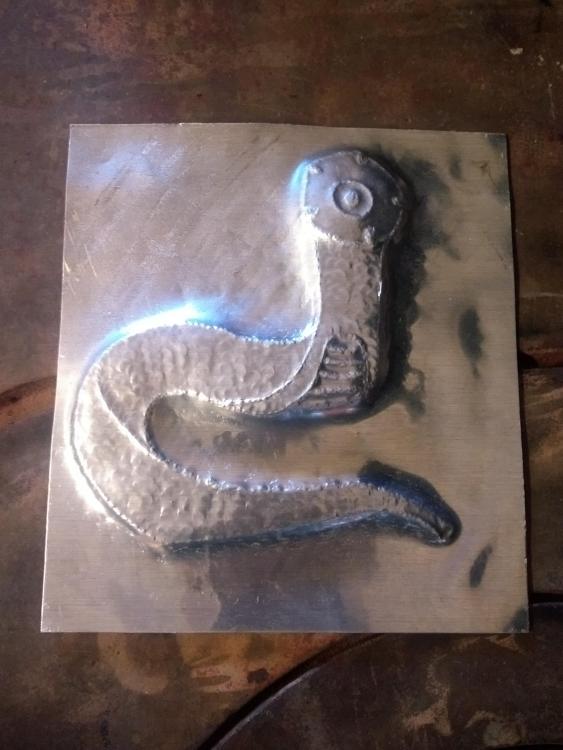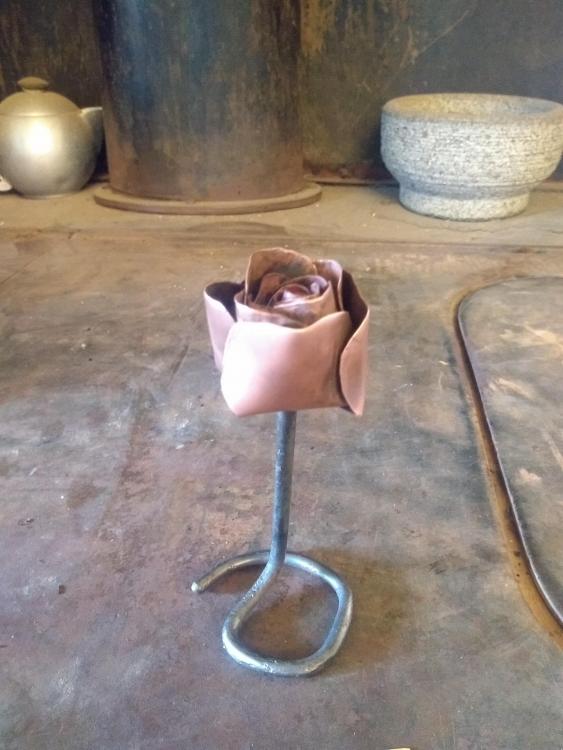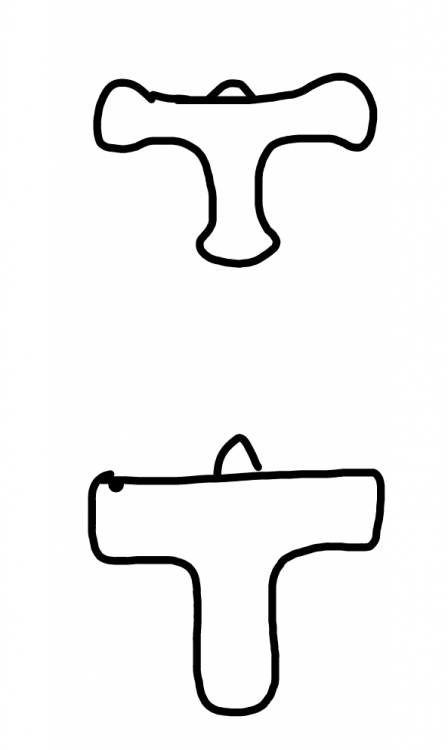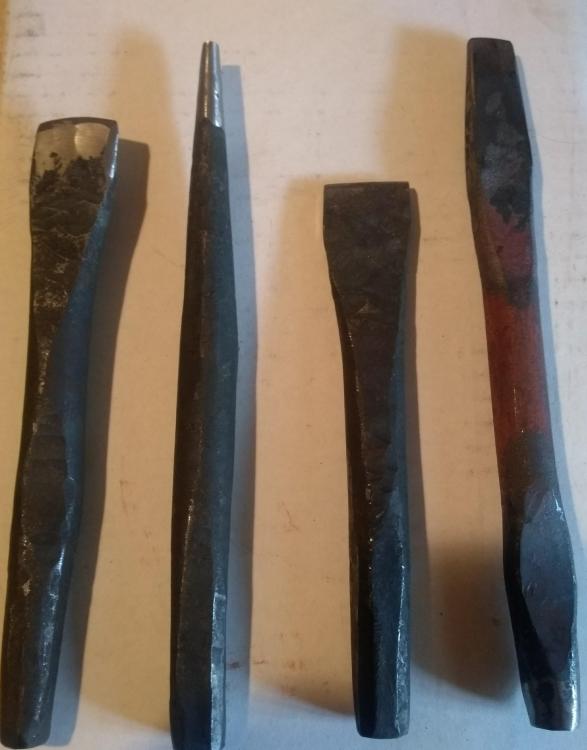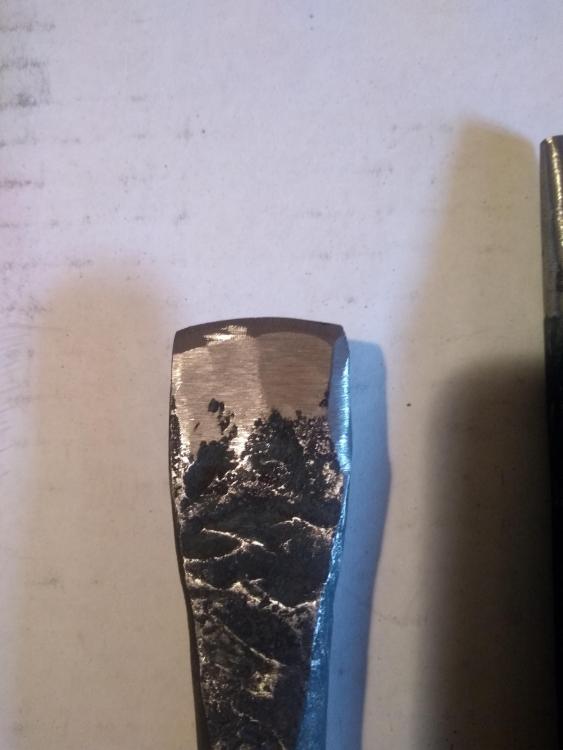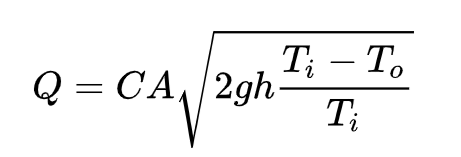-
Posts
399 -
Joined
-
Last visited
Content Type
Profiles
Forums
Articles
Gallery
Downloads
Events
Everything posted by Shabumi
-
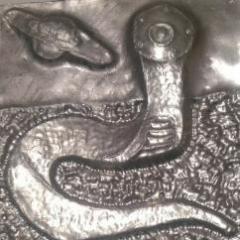
What did you do in the shop today?
Shabumi replied to Mark Ling's topic in Blacksmithing, General Discussion
Everything looks great everyone. Today I did a little repousse on a 6in² piece of alluminum sheet I had laying around, the first time I've done anything more than a random practice design, also first time using alluminum. I broke through in one spot, right side under the eye, but all in all it went ok for using nails as tools and cardboard on top of a block of wood for 'pitch'. The design came from my doodle book from high school. Also did my first copper rose yesterday. -

Calif Blacksmith Assoc. Conference April 25-27, 2019
Shabumi replied to Glenn's topic in Events, Hammer ins, Where to meet
Finally something local-ish for me to go to. Anyone else going? -
My go to unbending fork is a tree with a crotch in it, if it's a stubborn bend I slip a pipe over the post to get more leverage. I've straightened hundreds this way cold, and there is usually a tree like this within walking distance of the fence line
-
I went out and looked in our t-post pile after reading this post. The cross section of the newer ones have thinner arms with boulbus ends while the arms of the older ones of the same size are thicker but straight. Like the drawing. The older ones are definitely heavier and stiffer. But I think it's just the extra material instead being made of "better" material. I have seen both old and new ones snap. I think it was based more on where the force was applied, usually pushed on by the cow near the ground, instead of near the top of the post. I've also seen trees that fell right on top of some and though they didn't break, they were so bent they weren't salvageable. Maxwell, I had the same thought as you about using a t-post for tongs when I didn't have any. While I was working on building my skills to make them I got a set of wolfjaws as a gift, so I never got around to trying. When I took a tong making class where we used stock closer to the final product, I realized the amount of work it takes to get a halfway functional pair, so I agree with the others saying that it'd be more work than it's worth to use a t-post. If your a scrap artist I have seen some pretty cool uses for them. Spinal columns for skeletons or dragons, twisted with round or square stock in the grooves for table legs, or Luna moths with the T arms peened into wings and the "tooth" on the t-post cut into antenna
-
You could have a school of anvils for students. There are a few other animal group names that could work as well. A Sounder, a smack, a pride, a labor, a drift, a mob. You could even have a cast of ASOs
-
1) Name: Josh Gibbins 2) Location: about a half hour outside of Nevada City, CA 3) What type blacksmithing do you do, what do you make? As of now, tools to make what I want to do. What do I want to make? Gates, fences, garden art, hardware, trinkets ect. 4) How and when did you get started in blacksmithing? I'd been interested for as long as I can remember, but about 6 months ago I found an anvil in the barn where I live and decided to start. 5) What object or thing did you use as your first anvil? The ~98lb Peter wright anvil from the barn 6) Tell us about your first forge, hole in the ground, camp fire, brake drum, stacked bricks. It was a JATROD, a tire rim of dirt with an exhaust pipe between a hair dryer and the forge. 7) Who assisted you or encouraged you in the craft. It's mostly been everyone here on IFI who has assisted me. I'd have to say my family has encouraged me to follow through with smithing, though I see their eyes glaze over when I start speaking in smithing jargon. 8) What event changed your attitude about blacksmithing. Finding the anvil in the barn 9) What tool has changed or made your life easier in the shop. Tongs that fit the piece I'm working on. It's amazing how much easier it got when I wasn't fighting to hold on with every hit. 10) What advice would you give those starting out in blacksmithing. Find someone to help teach you. 1 hour with someone showing you what to do can teach you way more than 10 hours of trying to learn on your own 11) What advice would you give those already involved in blacksmithing. Find someone to teach, their "ignorant" questions can provide another way to look at things 12) What are some of the interesting things that have happened to you in your life as a blacksmith? Besides a couple of close calls with hot metal, nothing to interesting has happens to me... Yet
-

Etiquette when working in groups
Shabumi replied to Shabumi's topic in Blacksmithing, General Discussion
Thank you ID. I looked it up and it's definitely that style forge, I'd say it looks more like the #133 double width based on the dimensions I remember -

Etiquette when working in groups
Shabumi replied to Shabumi's topic in Blacksmithing, General Discussion
Then how would you hold your tongs? -

Etiquette when working in groups
Shabumi replied to Shabumi's topic in Blacksmithing, General Discussion
When the instructor was learning, they were carrying it up high when someone lost their grip and a piece of hot metal went down someone's tucked in shirt. So the rule in his class is to keep the metal as low as you can while moving it. I did have a few choice words for the fellow who almost got me, and when the instructor came to see what was going on I showed him my pants. He took away the forge priveliges of the offendee for an hour, and then watched as he proved he can be safe when moving metal. I know an hour doesn't sound like much time, but in a 3 hour class with discussion first he lost half his usable time. He was alot humbler after that, hopefully it carries through to next class. As I think about it, would it be considered a paid class if all you pay for is the nonrefundable materials fee? Honestly though, the class isn't as bad as this post makes it sound. I was mostly just venting after a bad day. Though if things don't change, or get worse after I talk with the instructor, I will end up walking away. -

Etiquette when working in groups
Shabumi replied to Shabumi's topic in Blacksmithing, General Discussion
The class was after hours at a local highschool. It is a paid class, but only 6 were supposed to be in the class. The other 2 were more advanced students(though they don't act like it), who had permission to use the forge with the class. 6 anvils, so at least there was plenty of those. 7 if you count the cast ASO in the corner that was used an example of what not to get. 4 vices, 2 post, 2 bench. The first day wasn't bad at all, one piece per person. The problem was when the instructor said at the end of the first class that we could bring in projects from home to work on in class. So yesterday it seemed like there were 3-4 pieces per person in the forge. I took the class to learn, so I stayed with the project at hand. I can work on my own projects at home. The "always announce when moving hot metal" wasn't meant to announce to the whole class, just the people your moving past. When I was hot rasping my slitter, I caught someone moving hot metal behind me with my elbow because I didn't know he was there. My elbow caught him and he spun towards me, burning the back of my pant leg with his work. A simple "coming behind you" would have prevented this. The forge is built in, has a huge footprint in the forging section of the shop so it already takes up alot of space, and I don't know if the school would allow another forge. I hate being a worry-wort, but I'm going to bring my concerns up to the instructor before next week's class to see if that helps. Otherwise I'll just keep playing second fiddle to the others who are too impatient to wait 30 seconds more to heat their work, and stay out of the way while I wait. -
I was at a class earlier tonight and there were 8 people sharing one forge. I'm not sure what kind it was, but the best description would be a natural gas pit forge. It was about 2ft x 1ft x 1.5ft with brick sides and an open top. The burners came in from the bottom of one side. I noticed everyone crowded their work peices in the hot spots. I would put my piece a little out of the way, sure it took a little longer to heat up, but I wasn't fighting everyone for the hot spot. If I had knocked someone's piece while I was putting mine in, then I would carefully put it back. But not everyone was as nice as me, in fact it was like a free for all to get the hot spot. I even saw a couple people move another's piece out of the forge to put theirs in it's place. There were other things as well. I had asked another class mate to hold my work while I made the first few hits with my slitter, after it was set I could get the rest of it without assistance. But 2 heats later, his tongs start grabbing my work WHILE IM HAMMERING. I know his intentions were good, and I politely told him I didn't need any more help, but it really irked me. Ok my late night vent is over. So, while I was driving home, I thought of a few things that I feel would be considered good etiquette when sharing a forge. Some I thought would've been common sense, but that's not so common anymore. In no particular order 1. If you move someone's work when you remove or return your work to the forge, put it back where it was. 2. Worry about your own work, not someone else's. 3. Don't grab anyone else's work without being asked to. 4. Always announce when hot metal is moving to and from forge/anvil/vice. 5. If it's not your tool, ask before using it, and put it back when your done. 6. If you need help, ask someone not in the middle of something. This is just what I could come up with. If there's anything you'd like to add, please do.
-

It takes money to blacksmith !!!!
Shabumi replied to rthibeau's topic in Blacksmithing, General Discussion
I kinda agree with Marc on this, except I feel it's a holographic representation of your own perception. Who's to say what I see is what you see? I can describe it, and my description may match what you see, but is what we both percieve exactly the same? Does it matter? Does it take money to blacksmith? Yes. Somewhere along the line you are going to have to pay for something. How much you pay is entirely up to you. Whether you buy a new hammer from a box store, used from a yard sale or make your own, it costs something. Even if you get all your tools, materials, and fuel for your forge for free, you'll have to pay for the gas to get them to your forge. And don't forget to bring a towel -

First solo Tamahagane smelt
Shabumi replied to vincentmarche's topic in Smelting, Melting, Foundry, and Casting
These puns are just gar-ish. I shadn't have started reading them in the first place -
Very interesting. I found alot of info on it on the first search of "ultrasonic weld". From that quick search I found out it's called "Ultrasonic Impact Technology (UTI)" which is used for tensile stress reduction(annealing) and/or introducing beneficial compression stress(work hardening) on welds. It can be used to treat hard to reach areas without any heat, and it's programmable for consistent results. It has been effective on alluminum, bronze, Cobalt alloys, nickel alloys, steel, and titanium. Where I've been mulling over my idea for months without being able to find any info on it. It took me 5 min to find all this info with the right search terms. Guess my google-fu isn't as honed as I thought. Now that Im on the right track, it's time to do more research. Thanks Jennifer.
-
Thanks for the answers everyone, and the book TP &JLP. I have it downloaded and it's on my reading list. After posting I thought it through and reasoned it probably wouldn't work, but for different reasons than stated above. I thought the carbon fiber would burn out before you got the rest of the metal to welding heat, leaving you with ash. The ash could be used as a flux to weld the two halves together I guess. It was just an odd ball idea that popped into my head, so I thought I'd ask. I have a bunch of those floating around in here... Differentially electro-magnetized levitating anvil(DC power wrapped around anvil 'stand' and wrapped reverse around anvil feet to magnetize and levitate, AC power wrapped just under face to demagnetize. The stand is a large metal block with tracks above it to keep anvil at right height and to stop wandering), cymatic casting/annealing table(using sound or micro vibrations to align the crystaline matrix while cooling), bacon matzo ball soup(bacon pieces in the matzo balls, not kosher but it would taste amazing). The list goes on and on. JLP, that hammer looks great. Would love to see it when it's done... Never mind, I see it's on its own thread in the hammer section. It looks great.
-

What did you do in the shop today?
Shabumi replied to Mark Ling's topic in Blacksmithing, General Discussion
Made my first set of tongs yesterday. Had a bit of time before the class ended so I added a little scrolling on the ends of the reins. It makes it look like I meant to make the ends uneven -
I've been reading up on carbon migration, and I just had an off the wall idea. Could you take a thin sheet (~1% of billit size) of carbon fiber and sandwich it between 2 pieces of mild steel, forge weld it together and fold it a few times to homogenize it to get a billit of hardenable steel?
-

What did you do in the shop today?
Shabumi replied to Mark Ling's topic in Blacksmithing, General Discussion
I went to my first 2 classes this week. Both local-ish, 1.5-2 hours away. Saturday was an 8 hour class about making tools. Hot cut, cold chisel, and ¼ inch round punch. This Saturday we will be using these tools to make tongs(useable tongs hopefully). Yesterday was a different class, only 3 hours but we made a ⅝inx⅛in slitter to cut a hole in a rr spike to make a "hatchet" next Thursday. Didn't have enough time to sharpen the cut and chisel on Saturday, but I got them hardened and tempered, so I took the extra half hour yesterday after hardening and tempering the slitter to sharpen them. This pic isn't quite chronological, I made the hot cut first, then the cold chisel, then the pinch and the slitter was made last. All were made from sucker rod. The teacher told us to sharpen the front face of the hot cut and leave the back face thick so it'd be easier to rock it forward when cutting long sections and the back will spread the cut as you move forward. I hope it shows in the picture. I like the idea, but I haven't tried it out yet. I did try the cold chisel and it does cut. I'll see how the punch and hot cut work tomorow. -

Chimney size, Chimney bends, and Tuyere size
Shabumi replied to Glenn's topic in Chimneys, Hoods, and Stacks
I haven't read this book yet, and I'm sure the author has much more practice in building and using forges and chimneys than me, but this doesn't make sense to me. My logic is telling me the chimney size should be based off the size of the fire pot, or more specifically the size of the fire instead of the size of the forge. The rest of the forge is essentially table space and shouldn't effect the way the chimney works. If you have a larger fire pot in a 18" forge, then a 6" flue wouldn't be up to the task. The 1/3 rule may be true for commercially available forges, but the only commercially available forge I've used was set up outside, so I can't say either way what chimney would work with it. I'll have to get that book and give it a read. You are correct about wanting to keep the chimney as warm as possible, but let's take a look at the difference of 8" vs 12". Using the the equation above, and assuming the temperature of the gas leaving the chimney is 400°f (semi-random number pulled from another post on flue temp) and keeping all other variables the same. 10ft of 8" pipe will move 232ft³/minute. 10ft of 12" will move 524ft³/minute. To get the same amount of air movement from the 8" you would need to extend the chimney to 50'. By using the insulated pipe, you reduce the temp loss. This will increase the temp at the chimney exit, where the measurement is taken, and you would be able to cut down on that length. If you plan on using the 6" it would take 160' to get the same draft as only 10' of 12" pipe. I'm not saying that 8" or 6" won't work, just that you will need more height to be as effective as a 10" or 12". For those interested I put together a little "chart" illustrating the equivalent draft of different size flues. 10' of 12" pipe= 20' of 10"= 50' of 8"= 160' of 6" 10' of 10" pipe= 25' of 8"= 75' of 6" 10' of 8" pipe= 25' of 6" Again this is assuming it's a perfect world and all factors besides height and diameter are the same. I did check with several other random temp values and heights and these numbers seems to hold true whether it's a 100° or 5000° difference from chimney to outside air and from 1ft to 100ft of height. Also, I apologise if I seem direct, abrubt or even rude in any of my posts, its not my intention. I'm not like this in person, but I've been told by many people I need to be more personable when I write. I try, but it's tough. Just call me on it if it gets too bad. Oh, and your welcome 8up, I'm glad I can help. -

Chimney size, Chimney bends, and Tuyere size
Shabumi replied to Glenn's topic in Chimneys, Hoods, and Stacks
In regards to chimney size. Ive seen this equation for induced flow stack effect (chimney draft/draught) a few times in separate sources, but the easiest to find was from Wikipedia. Keep in mind this is assuming it's just a straight verticle chimney with wide open ends and no friction from bends or elbows. The main forces that drive a naturally drafted chimney are: Q- draft A- cross sectional area of chimney(diameter) h- height of chimney. All the Ti/To mumbo-jumbo- temperature difference between the inside of the chimney and outside of chimney, measured at the exit of the chimney. C and g don't have much bearing on this description. g is gravity and C is based on the shape of the entrance and exit of the chimney. By looking at this equation, the area of the chimney has the biggest effect on draft. Height and temperature have less pronounced effects, but are still very important. With a forge, it's a bit if a balancing act. With a bigger diameter chimney you have to heat up all that extra volume in the chimney to get the draft. Too large and the smaller fire of a forge just isn't up the the task. That's why going to larger diameters doesn't work as well. Taller chimneys help pull more air, but they to have a limit. Too tall and the gasses cool down inside the chimney before they exit and have nowhere to go but down (cold air sinks). The ceiling for that is higher than most people will get to, so for simplicity's sake let's just say taller is better. On a side note. Notice I'm talking about height, not length. This equation is measured vertically from the top of the entrance to the bottom of the exit of the chimney. Any distance covered horizontally actually reduces draft, so a chimney that is 20ft long but goes at a diagonal 15ft up will draft less than a 20ft chimney that's straight up and down. For the temperature part. A forges fire is hot but it's relatively small, so it can't heat up a huge amount of air. If you have the entrance of the chimney too far away from the heat source, it will pull in more surrounding air, cooling the air so the chimney can't draw properly. But if you have it closer to the fire it will pull in the heat before it dissipates and will draw better. As Glenn said above there is no one chimney fits all solution for a forge, but the consensus seems to be a 10-12in chimney, as tall as you can get it, and have the entrance as close to the heat source as you can get it. You might be able to get away with a 8in if you have enough height to compensate for the smaller diameter. Another side note. If there isn't any air coming in to your shop to replace the air going out the chimney it won't draft. Air going out= air coming in and visa-versa. No air coming in means no air going out. I think that about covers my understanding of how a chimney works. I hope it doesn't confuse more than it explains. -
Seems like you know what your body needs. I have to deal with people where I work who have the Idiocracy mindset. Water is the stuff in the toilet and if something has got electrolytes it must be good, no matter what else is in it (it's what people crave). That's why I try to steer people away from Gatorade as their only hydration source. I understand what it's like to have to force myself to stop to eat/drink. I usually push through work until it's done, to the point of being too hungry to eat. That's where I use beer or a high sugar content drink to jumpstart my metabolism until I can eat something more substantial. I don't like the way I feel when I have to do that, so I try to prevent it instead of correct it.
-
A gallon of Gatorade?! That may be too much of a good thing. If you pay attention to professional athletes on the side lines, they generally drink a little Gatorade from the cooler and then the rest is water in a bottle with the Gatorade logo on it. While it does have electrolytes in it, the electrolytes are mostly sodium and potassium. Sodium you can get from any food with salt in it and potassium is found in alot of fruits, veggies, beans and grains, and lean meats. That steak on the grill has all the electrolytes you would get from Gatorade without the large amount of sugar. I'm not against sugar intake in any way, but a gallon of Gatorade has over 100 grams of sugar, which is just to much to be healthy. Sure you get an energy boost from it, but it also contributes to a "crash" when your body burns through it, unless you supplement it with something that breaks down slower, like protein, fat or a more complex carbohydrate. For hydration, I just use water. If I'm looking for electrolytes, my go to is tomato juice. It has many more electrolytes, alot less sugar, complex carbs that break down slower so I don't crash, and I can say I'm getting my veggies. Heck it even has some fibre in it. This way I'm able to work longer due to a gradual energy reduction instead of being fine one minute and done the next. BTW, that is a great looking forge Bean. Way better than my first forge
-
Wow! You sir, do amazing work. Luckily pictures don't need translation. настоящее вдохновение (a true inspiration)

